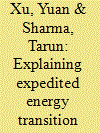| Srl | Item |
| 1 |
ID:
185720


|
|
|
|
|
| Summary/Abstract |
Energy transition toward renewables, mainly wind and solar, has gained momentum in the past decade. Although the COVID-19 pandemic brought unprecedented, multi-faceted challenges and uncertainties, India witnessed an expedited energy transition in 2020. With our newly constructed Electric System Dispatch Model for India (ESDMI), this study aims to provide an explanation of the underlining mechanisms. The Janta Curfew (7am-9pm) in India was observed on March 22, 2020 followed by a 21-day complete lockdown starting March 25, 2020 to control the spread of the virus. Electricity demand in India dropped by nearly a quarter. We model the supply-side dynamics prior to and during the pandemic response as well as in a counterfactual scenario in the pandemic's absence. We find that the expedited energy transition could be explained by (i) the higher priority of a large renewables fleet to access electric grid either through stipulations and the merit order effect, and (ii) coal-fired electricity generation is less flexible than natural gas and hydropower units. A substantial amount of coal-fired power plants in India are still far from reaching their designed lifetimes. Their low resilience in such crises could exacerbate the problem of stranded assets.
|
|
|
|
|
|
|
|
|
|
|
|
|
|
|
|
| 2 |
ID:
166409


|
|
|
|
|
| Summary/Abstract |
Energy system optimization models (ESOMs) form a critical component of a suite of modelling tools used by policy makers to understand (i) evolving complexity in energy systems arising from intersectoral coupling and other considerations at different spatial and temporal resolutions and (ii) uncertainty and sensitivity to assumptions and model parameters which entails analysis of a multitude of scenarios. Such enquiries are partly restricted by increasing computational times which can range from hours to days. To appease this restriction, we report our attempts at formalizing the performance testing of running ESOMs on a High Performance Computing (HPC) facility. The goal is to provide an assessment of the potential of a HPC environment to minimize solution time. Reporting on the outcomes, we present the scaling performance of the Irish TIMES, ETSAP-TIAM and JRC EU TIMES models by demonstrating solution time improvement on scaling across components of a HPC facility. Such facilities permit parallel runs of model instances. We identify and characterize the benefits and trade-offs of forking as a strategy in solution time reduction. Such capability permits policy makers and modellers to pose and derive insights to increasingly relevant questions on inter-sectoral coupling and risks that energy systems face due to uncertainty.
|
|
|
|
|
|
|
|
|
|
|
|
|
|
|
|